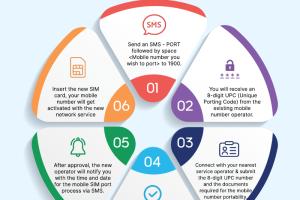A Comprehensive Guide to Seamless Mobile Phone Number Porting

-
Quick Links:
- Introduction
- Understanding Number Portability
- Benefits of Porting Your Mobile Number
- How to Port Your Number: A Step-by-Step Guide
- Common Challenges and Solutions
- Case Studies
- Expert Insights
- FAQs
Introduction
Porting your mobile phone number can seem daunting, but it doesn't have to be. In this comprehensive guide, we will walk you through the entire process, ensuring you understand every step along the way. Whether you are switching carriers for better service or to save money, our guide will equip you with the knowledge to make the transition as smooth as possible.
Understanding Number Portability
Number portability refers to the ability to retain your mobile phone number when changing service providers. This process is regulated by telecommunications authorities in most countries to promote competition and consumer choice.
The concept of number portability was introduced to eliminate the hassle of changing your number each time you switch carriers. It encourages users to seek better services without the fear of losing their established contacts.
Benefits of Porting Your Mobile Number
- Retain Your Contacts: Keep your existing contacts without needing to inform everyone about a new number.
- Better Plans: Switch to a carrier that offers more competitive rates or better service.
- Improved Coverage: If your current provider has poor service in your area, porting allows you to find a better option.
- Consumer Empowerment: Encourages competition among carriers, leading to better overall service.
How to Port Your Number: A Step-by-Step Guide
Follow these steps to successfully port your mobile number:
Step 1: Research New Carriers
Before initiating the porting process, research potential new carriers. Compare plans, coverage maps, and customer reviews to find the best fit for your needs.
Step 2: Check Eligibility
Ensure that your number is eligible for porting. Most mobile numbers are portable, but it's best to confirm with your new carrier.
Step 3: Gather Required Information
You will need to provide certain information to your new carrier, including:
- Your current phone number
- Your current carrier's name
- Your account number and PIN (if applicable)
- Your personal identification information
Step 4: Initiate the Porting Request
Contact your new carrier to initiate the porting request. They will guide you through their specific process.
Step 5: Wait for Confirmation
Once the request is submitted, you will receive a confirmation. The porting process can take anywhere from a few hours to several days, depending on the carriers involved.
Step 6: Test Your New Service
After receiving confirmation that your number has been ported, test your phone to ensure service is functioning properly.
Common Challenges and Solutions
While porting your number is typically straightforward, you may encounter some challenges:
Challenge 1: Delays in Porting
Solution: If your porting takes longer than expected, contact both your old and new carriers for updates.
Challenge 2: Losing Service
Solution: Ensure that your new carrier has confirmed the successful porting before canceling your old service.
Challenge 3: Inaccurate Information
Solution: Double-check the accuracy of your account information and ensure it matches what your current carrier has on file.
Case Studies
Here are some real-world examples of individuals who successfully ported their numbers:
Case Study 1: John’s Switch for Better Coverage
John lived in an area where his previous carrier had poor coverage. After researching options, he switched to a new provider that offered a better signal and saved money on his monthly bill.
Case Study 2: Sarah’s Experience with Delays
Sarah faced delays in her porting process due to incorrect information. After contacting customer support from both carriers, they resolved the issue, and she successfully ported her number.
Expert Insights
According to telecommunications expert, Dr. Jane Doe, “Understanding the nuances of number portability can save consumers a lot of time and frustration. Always follow up with carriers during the process.”
FAQs
1. How long does it take to port a mobile number?
Porting typically takes a few hours but can take up to 3 days depending on the carriers.
2. Will I lose my contacts when I port my number?
No, you will retain your contacts as your number remains the same.
3. Do I need to cancel my old service before porting?
No, your new carrier will handle the cancellation of your old service once the porting is completed.
4. Can I port my number if I still have a contract?
Yes, you can port your number, but you may incur early termination fees from your current carrier.
5. What happens if my port request is rejected?
If your request is rejected, check with both carriers for the reason and ensure your information is accurate.
6. Is there a fee to port my number?
Most carriers do not charge a fee for porting a number, but it's best to check with your new carrier.
7. Can I port a prepaid number?
Yes, prepaid numbers are usually eligible for porting as long as they meet the requirements of the new carrier.
8. Do I need a new SIM card when I port my number?
Yes, you will typically receive a new SIM card from your new carrier.
9. What if I don’t receive confirmation of my porting?
Contact your new carrier to check the status of your porting request.
10. Can I port my number internationally?
International number portability varies widely by country and carrier, so check with your providers.
Conclusion
Porting your mobile phone number can be a smooth process if you are well-informed and prepared. By following this comprehensive guide, you can make the transition seamlessly and enjoy the benefits of your new carrier.